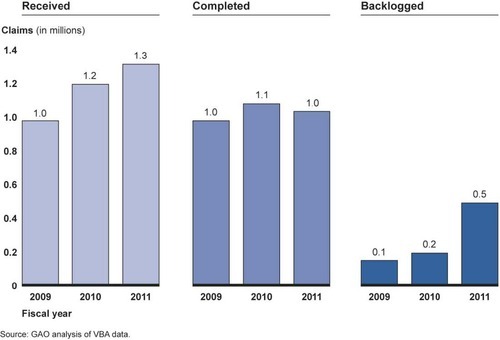Below is a summary of the process for filing and processing a disability claim with the VA, as distilled in a General Accountability Office report this week (PDF) that was part of a Senate hearing on Wednesday. No wonder there is an enormous backlog.
“VA’s disability compensation claims process starts when a veteran submits a claim to VA (see fig. 1). A claim folder is created at 1 of VA’s 57 regional offices, and a Veterans Service Representative (VSR) then reviews the claim and helps the veteran gather the relevant evidence needed to evaluate the claim. Such evidence includes the veteran’s military service records, medical examinations, and treatment records from Veterans Health Administration (VHA) medical facilities and private medical service providers. Also, if necessary to provide support to substantiate the claim, VA will provide a medical examination for the veteran. Once VBA has gathered the supporting evidence, a Rating Veterans Service Representative (RVSR)—who typically has more experience at VBA than a VSR—evaluates the claim and determines whether the veteran is eligible for benefits. If so, the RVSR assigns a percentage rating.4 A veteran may subsequently reopen a claim to request an increase in disability compensation from VA if, for example, a service-connected disability worsens or a new disability arises.
“If the veteran disagrees with VA’s decision regarding a claim, he or she can submit a written Notice of Disagreement to the regional office handling the claim.5 In response to such a notice, VBA reviews the case and provides the veteran with a written explanation of the decision—known as a Statement of the Case—if VBA does not grant all appealed issues.6 If the veteran further disagrees with the decision, he or she may appeal to the Board of Veterans’ Appeals (the Board) which conducts a hearing at the veteran’s request, then grants benefits, denies the appeal, or returns the case to VBA to obtain additional evidence necessary to decide the claim. If the veteran is dissatisfied with the Board’s decision, he or she may appeal, in succession, to the U.S. Court of Appeals for Veterans Claims, to the Court of Appeals for the Federal Circuit, and finally to the Supreme Court of the United States.”
Footnotes:
4 VA’s ratings are awarded in 10 percent increments, from 0 to 100 percent. 38 U.S.C. § 1155. Generally, VA does not pay disability compensation for disabilities rated at 0 percent. As of December 2012, basic monthly payments ranged from $129 for a veteran with 10 percent disability and no dependents to $3,340 for a veteran with 100 percent disability and a spouse, two parents, and a child.
5 38 U.S.C. § 7105. A Notice of Disagreement is a written communication that a claimant uses to express disagreement with a decision.
And a few graphics from the report that help illustrate the process and the backlog. Note: Click on the image for a larger, easier-to-read version.
Figure 1: Overview of VA’s Disability Claims Process
Figure 2: Timeliness of Phases in VA’s Claims Process for Fiscal Year 2011
Figure 3: VA Compensation Rating Claims Received, Completed, and Backlogged, Fiscal Years 2009 to 2011



